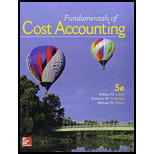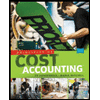
a.
Calculate the anticipated level of profit for the expected sales volume.
a.
Answer to Problem 58P
The anticipated level of profit for the expected sales volume is $1,110,000.
Explanation of Solution
Target volume: the level of sales which need to be achieved during a particular period of time is termed as target volume.
Target profit: the amount of profit which needs to be achieved during a particular period of time on a particular level of sales is termed as target profit.
Contribtuion margin:
| Particulars | Individual | Corporation | |
| Selling price per unit | $200 | $1,000 | 2000 |
| Less : variable cost per unit | $180 | $900 | 1800 |
| Contribution | $20 | $100 | $200 |
| Expected sales (unit) per year | 60,000 | 4,000 | 16,000 |
| Fixed cost | $3,690,000 | ||
Table: (1)
Compute the the anticipated level of profit for the expected sales volume:
Compute the profit level:
Thus, the anticipated level of profit for the expected sales volume is $1,110,000.
Working note 1:
Compute the total revenue:
Working note 2:
Compute the total variable cost:
b.
Assuming that the product mix is the same at the break-even point, compute the break-even point.
b.
Answer to Problem 58P
Company S must sell 46,125 tax returns of individual, 3,075 tax returns of partnership and 12,300 tax returns of corporation every year to break-even.
Explanation of Solution
Breakeven point (BEP): The breakeven point or BEP is that level of output at which the total revenue is equal to the total cost. The BEP means there are no operating income and no operating losses. The management keeps an eye on the breakeven point in order to avoid the operating losses in order to avoid losses.
Sales mix: This refers to the relative proportions in which a company’s products are sold. Sales mix is computed by expressing the sales of each product as a percentage of total sales.
Compute the individual tax returns that must be sold by Company S every year to break-even:
Compute the partnership tax returns that must be sold by Company S every year to break-even:
Compute the corporation tax returns that must be sold by Company S every year to break-even:
Thus, Company S must sell 46,125 tax returns of individual, 3,075 tax returns of partnership and 12,300 tax returns of corporation every year to break-even.
Working note 3:
Compute the combined break-even point:
Working note: 4
Compute the weighted-average contribution margin:
| Particulars | Sales mix (a) | Contribution (b) | Weighted average contribution margin (a*b) |
| Individual | 75%(5) | $20 | $15 |
| Partnership | 5%(5) | $100 | $5 |
| Corporation | 20%(5) | $200 | $40 |
| The combined weighted average contribution | $60 | ||
Table (2)
Working note: 5
Calculations of sales mix (weight):
Compute the individual mix:
Compute the partnership mix:
Compute the corporation mix:
c.
Calculate the new break-even volume for Company S If the product sales mix was to change to nine Individual-style bags for each Partnership style bag.
c.
Answer to Problem 58P
Company S must sell 27,000 tax returns of individual, 4,500 tax returns of partnership and 13,500 tax returns of corporation every year to break-even.
Explanation of Solution
Breakeven point (BEP): The breakeven point or BEP is that level of output at which the total revenue is equal to the total cost. The BEP means there are no operating income and no operating losses. The management keeps an eye on the breakeven point in order to avoid the operating losses in order to avoid losses.
Compute the individual tax returns that must be sold by Company S every year to break-even:
Compute the partnership tax returns that must be sold by Company S every year to break-even:
Compute the corporation tax returns that must be sold by Company S every year to break-even:
Thus, Company S must sell 27,000 tax returns of individual, 4,500 tax returns of partnership and 13,500 tax returns of corporation every year to break-even.
Working note 6:
Compute the combined break-even point:
Working note 7:
Compute the weighted-average contribution margin:
| Particulars | Sales mix (a) | Contribution (b) | Weighted average contribution margin |
| Individual | 60% | $20 | $12 |
| Partnership | 10% | $100 | $10 |
| Corporation | 30% | $200 | $60 |
| The combined weighted average contribution | $82 | ||
Table (3)
Want to see more full solutions like this?
Chapter 3 Solutions
GEN COMBO FUNDAMENTALS OF COST ACCOUNTING; CONNECT 1S ACCESS CARD
- Can you explain the correct methodology to solve this general accounting problem?arrow_forwardPlease help me solve this general accounting question using the right accounting principles.arrow_forwardSuppose during 2025 that Federal Express reported the following information (in millions): net sales of $82,500 and net income of $185. Its balance sheet also showed total assets at the beginning of the year of $27,000 and total assets at the end of the year of $23,000. Calculate the asset turnover and return on assets. (Round answers to 2 decimal places, e.g. 6.25 or 6.25%.) Asset turnover Return on assets times %arrow_forward
- The shareholders of Barley Corporation have voted in favor of a buyout offer from Wheat Corporation. Information about each firm is given here: Barley Wheat Price/earnings ratio 13.5 21 Shares outstanding 90,000 210,000 Earnings $180,000 $810,000 Barley shareholders will receive one share of Wheat stock for every three shares they hold of Barley. Required What will the EPS of Wheat be after the merger? What will be the P/E ratio if the NPV of the acquisition is 0? What must Wheat feel is the value of the synergy between these two firms? Explain how your answer can be reconciled with the decision to go ahead with the takeover?arrow_forwardI am trying to find the accurate solution to this general accounting problem with the correct explanation.arrow_forwardPlease provide the answer to this general accounting question with proper steps.arrow_forward
- Respond to jane Plant assets of DTPW are essential to the County’s transportation services and infrastructure. These assets consist of physical, long-term resources including our vast Metrorail and Metromover systems, maintenance facilities, administrative buildings, bus depots, and train stations. DTPW depends greatly on machinery such as fare collection machines, elevators, escalators, signaling devices, and track systems which are necessary to ensure that our daily operations go off without a hitch. For example, our buses and service trucks are regarded as plant assets since they help the department fulfill its goal of providing dependable and effective transportation across the County. These assets are valuable in addition to being physically noteworthy because they reflect large investments made to preserve accessibility, safety, and public transportation. For long-term planning and financial reporting, these assets have to be properly managed and their depreciation tracked.…arrow_forwardCan you solve this general accounting question with accurate accounting calculations?arrow_forwardPlease explain the correct approach for solving this general accounting question.arrow_forward
 Intermediate Financial Management (MindTap Course...FinanceISBN:9781337395083Author:Eugene F. Brigham, Phillip R. DavesPublisher:Cengage Learning
Intermediate Financial Management (MindTap Course...FinanceISBN:9781337395083Author:Eugene F. Brigham, Phillip R. DavesPublisher:Cengage Learning Principles of Cost AccountingAccountingISBN:9781305087408Author:Edward J. Vanderbeck, Maria R. MitchellPublisher:Cengage Learning
Principles of Cost AccountingAccountingISBN:9781305087408Author:Edward J. Vanderbeck, Maria R. MitchellPublisher:Cengage Learning Financial Reporting, Financial Statement Analysis...FinanceISBN:9781285190907Author:James M. Wahlen, Stephen P. Baginski, Mark BradshawPublisher:Cengage Learning
Financial Reporting, Financial Statement Analysis...FinanceISBN:9781285190907Author:James M. Wahlen, Stephen P. Baginski, Mark BradshawPublisher:Cengage Learning



